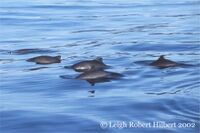Porpoise
| Porpoise | |
|---|---|

| |
| Harbour porpoise Phocoena phocoena | |
| Scientific classification | |
| Kingdom Information | |
| Kingdom | Animalia |
| Subkingdom | Bilateria |
| Phylum Information | |
| Phylum | Chordata |
| Sub-phylum | Vertebrata |
| Infraphylum | Gnathostomata |
| Class Information | |
| Superclass | Tetrapoda |
| Class | Mammalia |
| Sub-class | Theriiformes |
| Infra-class | Holotheria |
| Order Information | |
| Superorder | Preptotheria |
| Order | Cetacea |
| Sub-order | Odontoceti |
| Family Information | |
| Superfamily | Delphinoidea |
| Family | Phocoenidae |
| Genus Information | |
| Genera | Neophocaena Phocoena Phocoenoides |
| Population statistics | |
Porpoise refers to a group of dolphin-like mammals of the family Phocoenidae, consisting of three genera and eight living species found primarily in coastal waters world-wide. People often get dolphins and porpoises confused, but in reality they are very different from each other. Porpoises are not as friendly as dolphins are neither are they as trainable. They are friendly to an extent and trainable, but in comparing them to one another dolphins beat porpoises. A major difference between the two are their faces, porpoises do not have the beak for a snout but have a more rounded face. They are also smaller and more stout, but they have to eat so much more than any of their family because they are so small and live in such cold water and they can not hold any fat as well as most cetaceans.
They are very beautiful animals and very distinct. Porpoises are gray on top with a white strip and a white belly. They eat mostly bottom dwelling fish.
Anatomy
Porpoises are related to both dolphins and whales, but there is a big distinctions from dolphins to porpoises. For one they have flattened noses and spade shaped teeth. Porpoises are normally stout and short. They have rounded heads and very obvious looking jaws. Porpoises have a triangular shaped dorsal fin and some species have a bump on them, but the function of this bump has yet to be discovered.
Porpoises are very small mammals, the smallest of all cetaceans. The longest porpoise reaches eight feet and the smallest species, the Vaquita, only reaches to about five feet. They are also very light creatures. The lightest species of porpoises are Finless Porpoise and it only reaches to about sixty-five to one hundred pounds. And the heaviest porpoise is Dall's Porpoise, it gets to be two hundred and eighty to about four hundred and forty.
Because porpoises are so small they lose heat faster than other cetaceans, but their stout shape reduces surface area minimizing loss. Due to their small size, they have to eat more frequently rather than relying on fat reserves. [1]
Species
- Genus Neophocaena
- Finless porpoise, Neophocaena phocaeniodes
- Narrow-ridged finless porpoise, Neophocaena asiaeorientalis
- Genus Phocoena
- Burmeister's porpoise, Phocoena spinipinnis
- Harbour porpoise, Phocoena phocoena
- Spectacled porpoise, Phocoena dioptrica
- Vaquita, Phocoena sinus
- Genus Phocoenoides
- Dall's porpoise, Phocoenoides dalli
Reproduction
Porpoises used to live to the age of about thirteen years old, but now it is found that they only live until they are about eight years old. Females reach sexual maturity at about three or four years old. While the male will be sexually mature when they are about eight years old. Porpoises only reproduce during the months of July and August.
One of the few species to have both male and female monogamy are the Harbor Porpoises. The gestation lasts for about ten to eleven months. The female will only give birth to one calf each year, and the mother and calf maintain a very close bond. Porpoises give birth more frequently than most cetaceans, which more typically give birth every other year or every three years. [2]
Ecology
Differences of Porpoises
Although the porpoise and the dolphin are in the same family and many people will get them confused they are very different. In, both, the way they act and the way they look.
One way they are different from dolphins is in the way they look. They are much shorter and stouter than a dolphin and way a lot less. Porpoises have rounder heads that do not have beaks, they look more like they have jaws. They have spade shaped teeth compared to the dolphins conical shaped teeth. Porpoises also have different coloring; they are black on top and white underneath compared to the grey and white of the dolphin. Porpoises also have to eat a lot more than dolphins or most whales because they are so small they do not have any fat reserves making it very hard for them to hold their warmth. [3]
Another way dolphins and porpoises differ is in the way they act. You won't normally find porpoises in an aquarium because they don't adapt to tank life as well as dolphins do. They also can't learn tricks as well and don't get along with humans and dolphins do. They are not violent creatures, but aren't like dolphins. [4]
Threats
Bycatch deaths in fishing nets are their greatest threat, with the vaquita in the Gulf of California classified as critically endangered by the ICUN[1]; its wild numbers have dwindled to 18 mature individuals as a result[2]. In some countries, they are hunted for food or to use their meat as bait[3]. Porpoises are rarely kept in zoos or dolphins, as they are unable to adapt well to life in captivity and are not as easy to train as dolphins[4].
References
- ↑ https://www.iucnredlist.org/species/17028/50370296
- ↑ https://www.iucnredlist.org/species/17028/50370296#population
- ↑ https://www.researchgate.net/figure/Harbour-porpoise-meat-skin-and-heads-are-sold-for-food-at-a-Greenlandic-marketplace_fig1_280211062
- ↑ https://www.dolphinproject.com/blog/wayback-machine-dalls-porpoises-in-captivity/
Gallery
 Browse |
References
- (http://en.wikipedia.org/wiki/Porpoises) Wikipedia.
- (http://encyclopedia2.thefreedictionary.com/porpoise) Farlex.
- (http://kingfish.coastal.edu/marine/375/porpoise.html) Lisa Moulton and Sandra DeMaria.
- http://marinebio.org/species.asp?id=440 Marine Bio.



